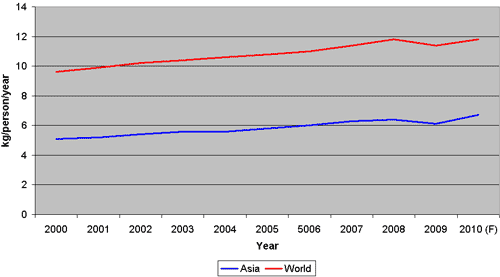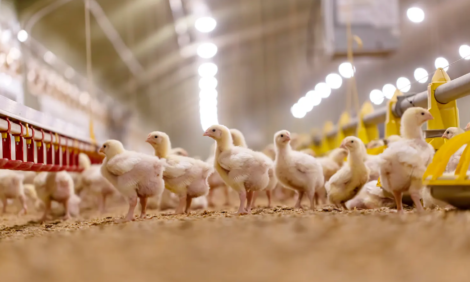



GLOBAL POULTRY TRENDS - Asian Chicken Meat Consumption Trends 2010
In the final part of our series of special features entitled Global Poultry Trends about Asia for ThePoultrySite, Terry Evans explains that within five years, 60 per cent of the world's people will live in Asia. Combined with a growing demand for all meats there, this region will account for an increasing share of global chicken meat output.Asia accounts for a little more than 60 per cent of the world's human population. However, globally, the rate of population growth is slowing and will average less than 1.1 per cent per year in the forthcoming decade. Nevertheless, between now and 2015, the world's population will expand by almost 400 million, of which nearly 60 per cent will live in Asia.
Table 1 shows the human population of Asian countries as well as the latest estimates for poultry meat and chicken consumption.
Combined, China and India account for 37 per cent of the world's population. The growth rate in China will slow from the 1.5 per cent a year recorded in 1981-1990 to 0.6 per cent a year during 2010-2019. The corresponding figures for India, the world's second most populous nation, are 2.0 per cent and 1.3 per cent, respectively.
Unfortunately, the FAO only calculates the uptake of poultry meat, and this data has not been updated since 2005. Between 2000 and 2005, average global consumption of poultry meat rose from 11.1 to 12.5kg per person, while in Asia, the corresponding figures rose from 6.8 to 7.6kg.

Generally speaking, the figures do not change dramatically (by more than 100 to 200g per person per year) from one year to the next.
No country actually measures consumption levels, these figures being arrived at by dividing estimates of available supplies by the population.
Using this procedure, it is estimated that the global average of chicken meat uptake went up from 9.6kg per person in 2000 to a record 'high' of 11.8kg in 2008. The trend in Asia was similar, with the average rising from 5.1kg to 6.4kg.
Last year (2009), the availability of supplies contracted which, when aligned to the increases in population, resulted in consumption contracting both globally and in Asia. However, this situation will have been reversed this year with the quantity eaten recovering universally.
For the next ten years, consumption gains are anticipated almost everywhere with FAPRI forecasting uptake per person in China averaging 11.1kg by 2019.
After increasing to 2.4kg by 2016 from 2.2kg in 2010, the average quantity eaten in India is expected to stabilise at that level to 2019. But, while any increase in uptake per person is important, it is equally so to take into account the growth in the human population. Between 2010 and 2019, India's population will expand from 1.215 billion to 1.353 billion. An increase in uptake of only 0.1g/person would expand the consumption of chicken meat by more than 400,000 tonnes from 2.7 to 3.1 million tonnes.
For Indonesia, an anticipated upturn will bring the average to 4.5kg by 2019, while in Japan, consumption is forecast to stabilise at around 15.8kg.
Compared with 2010, a one-kilo gain is expected in the Philippines pushing the average to 9.0kg by the end of the next decade. Even more rapid increases are projected for the Republic of Korea and Thailand as average uptake is expected to rise from 14.2kg to 15.4kg and from 12.4kg to 13.9kg, respectively.
The FAPRI forecast for Viet Nam reveals a gain of 0.5kg/person as the average hits 6.3kg by 2019.
There is a close correlation between real income growth and meat consumption, which is why the global economic crisis had a negative impact on poultry meat uptake. Clearly, this is a more important factor in developing than in developed economies. Again, rising feed costs, which eventually must be passed on to consumers, will have a greater adverse impact on poorer people, especially when considering that, in many countries, food expenditure can account for more than 50 per cent of income. However, on the plus side here, chicken has an advantage over its competitors being the more efficient converter of feed into food.
Thus, in Asian developing economies, population growth, improvements in real incomes, and a further reduction in production costs to maintain chicken's price advantage over competitors, are the key factors to expanding the demand for chicken. In the more sophisticated developed economies, where rising incomes have less of an impact on the demand for a commodity, further growth will primarily come from product innovation.
Further Reading
| - | You can view other articles in our series Global Poultry Trends by clicking here. |
June 2010









